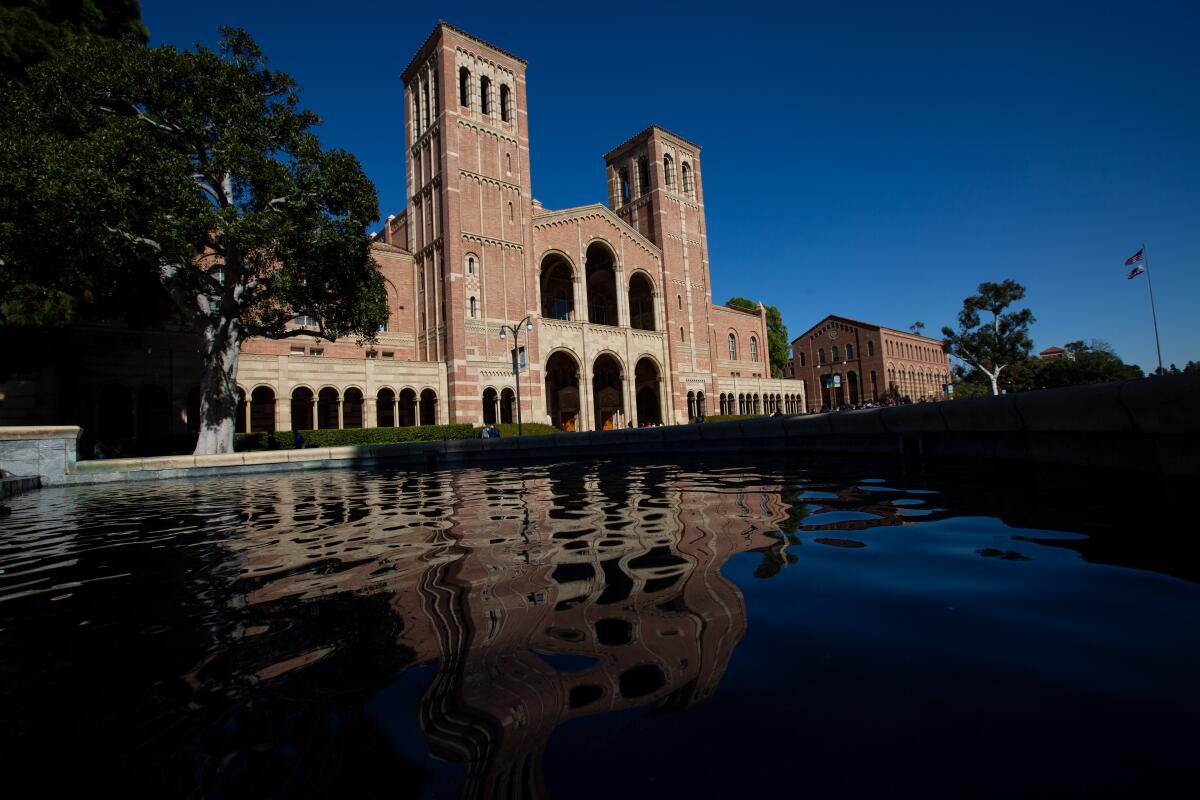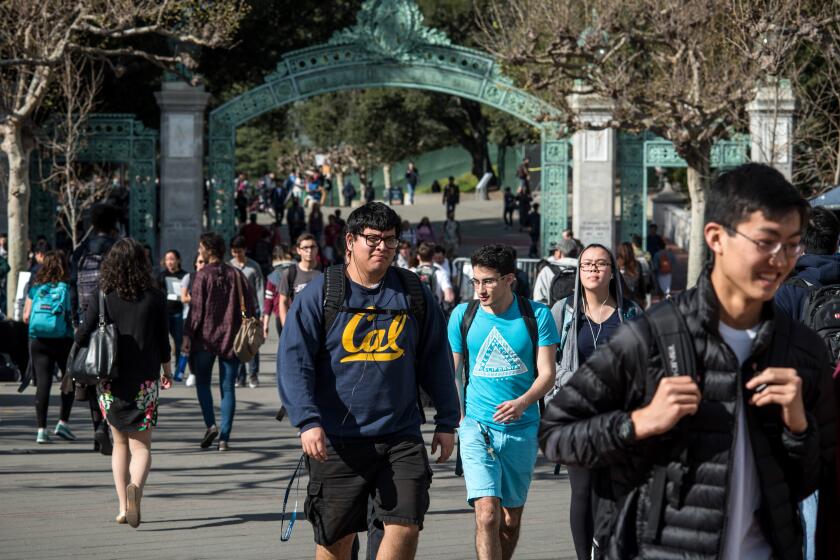A bold plan for UC: Cut share of out-of-state students by half amid huge California demand

- Share via
As the University of California faces huge demand for seats — and public outcry over massive rejections by top campuses in a record application year — state lawmakers are considering a plan to slash the share of out-of-state and international students to make room for more local residents.
The state Senate has unveiled a proposal to reduce the proportion of nonresident incoming freshmen to 10% from the current systemwide average of 19% over the next decade beginning in 2022 and compensate UC for the lost income from higher out-of-state tuition.
This would ultimately allow nearly 4,600 more California students to secure freshmen seats each year, with the biggest gains expected at UCLA, UC Berkeley and UC San Diego. The share of nonresidents at those campuses surpasses the systemwide average, amounting to a quarter of incoming freshmen. UC, however is pushing back, saying the plan would limit its financial flexibility to raise needed revenue and weaken the benefits of a geographically broad student body.
“It’s not about ending out-of-state students — they really add to the mix and the educational experience,” said Sen. John Laird (D-Santa Cruz), whose Senate budget subcommittee on education discussed the plan this month. “We just have to make sure there’s enough spaces for in-state students.”
The question of who should get a coveted seat in the nation’s premier public research university system has raged for years, as legislators are perennially pummeled by constituent complaints about UC access. The issue has ignited political fireworks, a scathing state audit, UC admission reforms and extensive policy work into how to accommodate the growing number of qualified California applicants amid limited funding and space.
Although the UC system is constitutionally autonomous and controls its own enrollment decisions, state lawmakers have used their power over purse strings to compel UC to adopt their directives.
The University of California, aiming to end fighting over how many out-of-state students it admits, on Tuesday announced a revised proposal to limit non-Californian and international undergraduates.
Under political pressure, the UC regents in 2017 capped nonresident enrollment at 18% systemwide, with a higher share grandfathered in for UCLA, Berkeley, San Diego and Irvine.
But some legislators are saying that cap is still too high — and that this is an opportune year to begin driving it down because Gov. Gavin Newsom has proposed using some of the state’s record $75 billion surplus to give UC $805 million, which university leaders have applauded as the largest investment in the university system’s 153-year history.
But Newsom has not tied that funding to increases in California student enrollment, as previous state budgets have done, and UC’s 2021-22 budget plan doesn’t include higher targets. The Senate 10% plan is the first volley in what is bound to be protracted negotiations over the issue before the June 15 deadline for legislative passage of the budget.
“We’re giving them a blank check and they’re giving us nothing in return for our priorities,” said Assemblyman Kevin McCarty (D-Sacramento), whose budget subcommittee also has long pushed for more California students. “When we go to our districts and talk to our constituents, access to the University of California is a front and center issue that we hear about.”
University of California admissions officers explain their decisions in a year of record applications that brought widespread heartbreak and some joy for high school seniors competing for spots.
UC officials say they share the goal of enrolling and graduating more California students and have added 19,000 more of them since 2015. But they oppose the 10% plan, saying nonresidents enrich the college environment for all students and pay more than $1 billion annually in supplemental tuition that helps fill budget holes. That revenue, officials say, has allowed UC to enroll more Californians not fully covered by state funding, as well as provide more faculty, staff, student services, financial aid and campus facility upgrades.
“We understand and support the Legislature’s goal of providing more opportunities for Californians at UC, though we believe trying to achieve this through reducing nonresident students will potentially lead to unanticipated outcomes,” the university said in a statement. UC called for a “stable and predictable revenue source” to increase California undergraduate enrollment without hurting low-income students or limiting efforts to recruit students outside the state.
For thousands of California families, however, the increasing difficulty of accessing a UC seat at many campuses after they’ve supported the university system with their taxes for years has fueled heartbreak, frustration and anger. And high school teachers and counselors want to see more of their hard-working students reap the rewards of a UC acceptance letter.
“We have the great privilege of having these extremely prestigious public universities in the state but the downside is they’re really popular and everyone is trying to get in,” said Heather Brown, college counselor at Los Angeles High. “It’s only fair that students of residents who have been putting tax dollars into the pot should benefit.”
The nation’s largest higher education systems will get a major funding boost under the proposed state budget announced by Gov. Gavin Newsom.
Weni Wilson, a San Marino parent, said the high-performing children of several of her friends did not get admitted to their top UC choices this year and the topic is so painful they’ve had to agree not to talk about college admissions in order to continue their social gatherings.
Wilson said her own daughter will attend UC Irvine this fall, but she supports the Senate plan as a way to open more access to other California students — including her two younger children who will be applying to college in five years.
“As a California taxpayer, I would expect and hope that the children of California residents have the opportunity to attend UC schools because right now the opportunity is taken away for a lot of these kids,” Wilson said.
The controversy began in the wake of the 2008 recession, when UC sought to offset major state budget cuts by aggressively recruiting and admitting more nonresident students, who each pay an additional $29,000 in tuition a year. As a result, the share of nonresident undergraduates systemwide tripled from 5% in 2007 to 15% in 2015.
In 2016, a state audit found that campuses harmed local students by admitting too many nonresidents. In a fiery response, then-President Janet Napolitano called the findings “unfair and unwarranted.” But UC regents, following an audit recommendation, approved the 18% cap.
State lawmakers, however, pressed for more changes — directing UC to develop a plan beginning in fall 2020 to gradually reduce nonresident students to 10%, but it was not implemented. Now, in a record-shattering year of more than 200,000 applicants vying for 46,000 freshman seats, the state Senate has made the enrollment issue one of its top educational priorities, Laird said.
Under the 10% plan, the share of nonresident students would be cut at UCLA, Berkeley, San Diego, Davis, Irvine and Santa Barbara but allowed to rise to that level at Santa Cruz, Riverside and Merced. The plan would replace the lost tuition from nonresidents and cover the cost of additional California students to take their spots, beginning with $56 million next year and growing to $775 million by 2033.
Seija Virtanen, UC associate director of state budget relations, told Laird’s subcommittee that it would be more cost-effective to fund more California undergraduates, whom the state funds at roughly $10,000 each, than cut the number of nonresidents and backfill their lost tuition at more than twice that amount. She also said the Senate plan could create a “financial vulnerability” for UC — if state funding were cut again, for instance, in another recession.
UC student leaders also have spoken out against the 10% plan. Aidan Arasasingham, president of the UC Student Assn., said students from other states and countries bring a vibrant diversity to campus and their talent and skills to California since most stay here and work after graduation.
“You can’t have a globally minded education without learning from peers from across the state, the country and world,” Arasasingham said. “Instead of building walls to keep certain students out, we need to build stronger bridges of opportunity for California residents to allow them to come here through increased access, more retention or the funding of new seats at UC.”
Even some supporters of the plan have some qualms.
“If the state isn’t able to fully compensate UC for the lost income from out-of-state tuition, are they going to have a higher ratio of students to professors? Are they going to have crumbling infrastructure?” Wilson asked. “Is it worth it to allow more kids in but then have a poor quality education?”
Assemblyman Phil Ting (D-San Francisco), who chairs the Assembly budget committee, said nonresidents made up only 5% of Berkeley students when he attended that campus three decades ago and returning to lower levels was “long overdue” — especially at the most highly sought after campuses. UCLA and Berkeley, he said, can’t significantly add more Californians without reducing nonresidents because they are at capacity with little physical room to grow.
At a February subcommittee hearing, Ting pressed UC President Michael V. Drake on whether UC should lower the 18% cap.
“It’s a complicated question,” Drake replied, adding he would be happy to work with legislators to find the right balance.
The Assembly also has supported the 10% plan and plans to flesh out details of its own UC proposal in the next several days.
“We have so many residents who are dying to go to UC and we want to give as many UC eligible students the opportunity to come to the University of California as possible,” Ting said.
More to Read
Sign up for Essential California
The most important California stories and recommendations in your inbox every morning.
You may occasionally receive promotional content from the Los Angeles Times.














